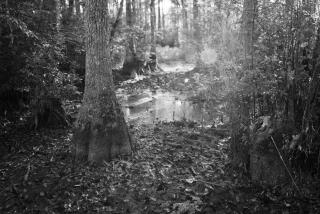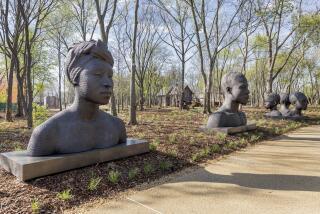Book Review : The Slave Uprising That History Forgot : DENMARK VESEY, The Buried History of America’s Largest Slave Rebellion and the Man : Who Led It; by David Robertson; Alfred A. Knopf $23, 210 pages
- Share via
Denmark Vesey is a name that ought to be known by every American high school student. Why it should be and why it is not are the subjects of this finely written account of the life and death of the uncommon man who planned to launch a massive uprising of South Carolina slaves in 1822.
In “Denmark Vesey,” David Robertson brings to light a remarkable tale. It is the story of a young slave well-regarded by his master, schooled in French and English, who by a stroke of luck--he won $1,500 in a lottery--purchased his freedom, lived respectably for years as a free man in Charleston and conceived of the idea of gathering 9,000 slaves into an avenging army to slay every white man, woman and child in Charleston, and then sailing away to Africa and freedom.
Robertson argues that Vesey nearly succeeded. At the last minute, by a bit of luck for whites, he was betrayed by some slaves. After a series of hurried sham trials, Vesey and 34 others were hanged.
Robertson is excellent at sketching the development of South Carolina by white settlers from Barbados, who brought slaves with them. White South Carolinians persuaded themselves that they were the benevolent masters of contented, less-than-fully-human slaves, but their fears belied their pious countenance. What they dreaded most was a slave rebellion, and the savagery of their response was proof of their feelings.
U.S. Supreme Court Justice William Johnson wrote to his friend, retired President Thomas Jefferson, “I have lived to see what I really never believed it possible I should see--courts held with closed doors, and men dying by the scores who had never seen the faces nor heard the voices of their accusers.”
“Remember Denmark Vesey of Charleston,” Frederick Douglass told recruits for the 54th Massachusetts Regiment of black volunteers led by Col. Robert Gould Shaw in the Civil War. “Liberty won by white men would lose half its luster. Who would be free themselves must strike the blow.”
Vesey, who in addition to English and French possibly spoke Gullah and Creole, made close alliances with slaves directly from Africa, with French slaves from St. Domingue and the Gullah-speaking slaves from South Carolina’s low country. Robertson argues, plausibly enough, that Vesey was acquainted with the principles of Islam, which may have contributed to the fierce pride, discipline and stern demeanor that his white judges found remarkable in him.
After the Civil War, outside of Charleston, Vesey was not much remembered by a nation anxious to get ahead and leave the issue of slavery behind. But at home he was revered, Robertson reports, as a founder of the AME Church, and was feared and loathed by Charleston whites well into this century. When, in 1976, black leaders in Charleston proposed to honor him with a portrait, a columnist for the Charleston News and Courier wrote that “they could not have found a local black whose portrait would have been more offensive to many white people.” The portrait was made and placed in Charleston’s Gaillard Auditorium. Since no one now knows what he looked like, it shows him from the back addressing his followers.
Robertson’s exploration of the “buried history” of Vesey illuminates aspects of American black and white history that should not be forgotten. It deserves a permanent place on America’s history bookshelves.
More to Read
The biggest entertainment stories
Get our big stories about Hollywood, film, television, music, arts, culture and more right in your inbox as soon as they publish.
You may occasionally receive promotional content from the Los Angeles Times.










